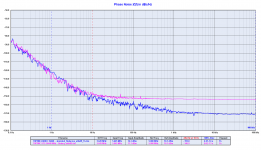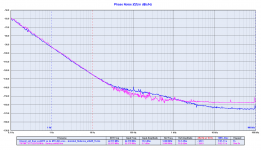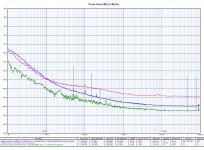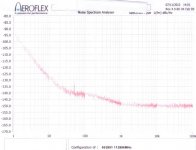Gerhard,
I forgot, in debug mode the software limitation is disabled so the Timepod can go down to DC (in software).
We have measured 192kHz and 176kHz and it looks like the measurements were correct.
But there is no way to go below 150kHz or so, we have tried and it doesn't work.
That's the reason we have planned to build the up converter.
Andrea
I forgot, in debug mode the software limitation is disabled so the Timepod can go down to DC (in software).
We have measured 192kHz and 176kHz and it looks like the measurements were correct.
But there is no way to go below 150kHz or so, we have tried and it doesn't work.
That's the reason we have planned to build the up converter.
Andrea
Last edited:
Although I have not personally done any testing on it, people I tend to believe told me wired ethernet is often a problem for some audio systems. Better isolation from noise getting into the dac might be a more appropriate solution. May depend if noise is getting into other reproduction equipment too.
So get a switch with SFP ports and run fibre to the end point. dunno why audiophiles don't do this. I suspect Toslink fear has put them off.
But is this real noise or audiophile noise ?
Based on what people I trust tell me, its probably some kind of real RF noise. No direct experience with it myself.
Bill,
Toslink can be as good as asynchronous USB by using something like one of iancanada's FIFO_Pi buffers. ASRC probably the next best thing, unless FIFO time delay were to be an issue; in that case ASRC might be best.
Toslink can be as good as asynchronous USB by using something like one of iancanada's FIFO_Pi buffers. ASRC probably the next best thing, unless FIFO time delay were to be an issue; in that case ASRC might be best.
Based on what people I trust tell me, its probably some kind of real RF noise. No direct experience with it myself.
Can't say I've noticed it. Then again I'm not the sort to go looking for it.
Ref. https://www.diyaudio.com/forums/dig...itter-crystal-oscillator-441.html#post6712460
The only relevant data would be the last plot; unfortunately it is in fact only an attempt to shift the focus. It compares the noise of a square wave filtered with two different LPFs. A direct comparison with the original low phase sine would immediately show that the phase noise floor is 10-20dB worse after the square conversion, compare the results above with the originals:
https://www.diyaudio.com/forums/dig...itter-crystal-oscillator-375.html#post6679177
Why is this so, there are at least two good reasons here;the first one is well studied in the literature, and in a nutshell concludes that the phase noise of the harmonics add up to the phase noise, there's no way around this, for example:
https://pdfs.semanticscholar.org/9440/fd4f0e2d65cfed307dfc30892fe9f0bf8c8d.pdf
The effect could be intuitively viewed as the hard limiter slope amplifying the phase noise with it's slew rate. It is though true that theoretically the phase noise degradation decreases at lower frequency offsets.
The second reason relates to the timepod principle; the input 27MHz filter is there as an anti aliasing filter for the internal ADC. This filter has inherently a much lower stop band attenuation compared to the noise floor of the original sine. As such, the out-of-band (over the Nyquist frequency) noise is aliased back in band and lead to an increased measured noise floor. For further details see:
https://www.analog.com/media/en/tec...7045254275316215330254506699244016AN741_0.pdf
Does this matter for audio? For sure not a iota, everything happens far beyond any audibility threshold. But to claim that the sine to square conversion process does not affect the phase noise, that's misleading.
The only relevant data would be the last plot; unfortunately it is in fact only an attempt to shift the focus. It compares the noise of a square wave filtered with two different LPFs. A direct comparison with the original low phase sine would immediately show that the phase noise floor is 10-20dB worse after the square conversion, compare the results above with the originals:
https://www.diyaudio.com/forums/dig...itter-crystal-oscillator-375.html#post6679177
Why is this so, there are at least two good reasons here;the first one is well studied in the literature, and in a nutshell concludes that the phase noise of the harmonics add up to the phase noise, there's no way around this, for example:
https://pdfs.semanticscholar.org/9440/fd4f0e2d65cfed307dfc30892fe9f0bf8c8d.pdf
The effect could be intuitively viewed as the hard limiter slope amplifying the phase noise with it's slew rate. It is though true that theoretically the phase noise degradation decreases at lower frequency offsets.
The second reason relates to the timepod principle; the input 27MHz filter is there as an anti aliasing filter for the internal ADC. This filter has inherently a much lower stop band attenuation compared to the noise floor of the original sine. As such, the out-of-band (over the Nyquist frequency) noise is aliased back in band and lead to an increased measured noise floor. For further details see:
https://www.analog.com/media/en/tec...7045254275316215330254506699244016AN741_0.pdf
Does this matter for audio? For sure not a iota, everything happens far beyond any audibility threshold. But to claim that the sine to square conversion process does not affect the phase noise, that's misleading.
Last edited:
Iancanada is working on his own squarer design. No doubt some people will want to try it to see if there is any audible difference on their systems between it and Andrea's versions. If there is an audible difference then at least that would be something which could be further investigated. Have to wait and see what happens, I guess.
Unless I'm missing something the square to sine phase noise test is not using the Drixo, or was this a real attempt to mislead with 'technobabble'?Ref. https://www.diyaudio.com/forums/dig...itter-crystal-oscillator-441.html#post6712460
The only relevant data would be the last plot; unfortunately it is in fact only an attempt to shift the focus. It compares the noise of a square wave filtered with two different LPFs. A direct comparison with the original low phase sine would immediately show that the phase noise floor is 10-20dB worse after the square conversion, compare the results above with the originals:
https://www.diyaudio.com/forums/dig...itter-crystal-oscillator-375.html#post6679177
Last edited:
Btw, How is powered the final squarer hat on the last TTWMC SC-Cut designs ? 3V3 by the Fifo Pi board on the DIL 14 socket ?
Change the power supply and how is decoupled that final power supply and it changes the sound ! I fear the comparaisons from a hearing session to be subjective in the end and the phase noise to be so low to be heard whatever the board origin at the end !
Change the power supply and how is decoupled that final power supply and it changes the sound ! I fear the comparaisons from a hearing session to be subjective in the end and the phase noise to be so low to be heard whatever the board origin at the end !
There is a big difference claiming that the sine to square conversion process does not affect the phase noise and claiming that the sine to square conversion process does not affect the CLOSE IN phase noise, that's what I claimed.
Plots have been published, sine to square conversion process affects the noise floor but it affects almost zero the close in noise.
The way in which the noise floor degrades is related to the slope of the sine wave to be converted, the lower the frequency the greater the degradation.
In fact the degradation is greater when converting 5.6448MHz sine wave in respect to 22.5792MHz one.
For me it's enough logical.
Plots have been published, sine to square conversion process affects the noise floor but it affects almost zero the close in noise.
The way in which the noise floor degrades is related to the slope of the sine wave to be converted, the lower the frequency the greater the degradation.
In fact the degradation is greater when converting 5.6448MHz sine wave in respect to 22.5792MHz one.
For me it's enough logical.
Attachments
The last sentence in #4456 is a different claim, but I won't nitpick. In all truth, I am not aware of solid data in the literature to compare directly the close in phase noise of the sine to square conversion, but it could be there... All I know is the conversion effect indeed decreases with the frequency deviation decrease.
Otherwise, we are back to the original debate if the clock close in phase noise has any effect on the audibility (while the phase noise floor is less important), in particular when considering the original music content wow, flutter, etc... Everybody may believe whatever they want, but every bit of logic says it doesn't. To each their own.
Otherwise, we are back to the original debate if the clock close in phase noise has any effect on the audibility (while the phase noise floor is less important), in particular when considering the original music content wow, flutter, etc... Everybody may believe whatever they want, but every bit of logic says it doesn't. To each their own.
Last edited:
last night 2 audiophile friends listened to an Ethernet switch with Andrea's clock, compared to a switch with ocxo raltron mounted on board.
the boys didn't know anything about the test, so try blindly.
The difference is obvious. Andrea's clock has won in every respect. thanks again Andrea for the work done.
Tannoy Stirling speakers with duelund crossover
Amp accuphase a30
roon rpi4- fifopi accusilicon clock- 9038q2m dual- basesik output trasfo.
great result! next step Andrea clock for fifopi
its so weird and should not happen, so there must be some reason to this.
it might help to solve the puzzle if you could show how you put these things together, especially the power supplies.
also have you check the throughput between the switches?
edit: or try cascade the switches with different order?
Last edited:
But without level matching and quick switching, it lacks the objectivity.last night 2 audiophile friends listened to an Ethernet switch with Andrea's clock, compared to a switch with ocxo raltron mounted on board.
the boys didn't know anything about the test, so try blindly.
The difference is obvious. Andrea's clock has won in every respect. thanks again Andrea for the work done.
Unless I'm missing something the square to sine phase noise test is not using the Drixo, or was this a real attempt to mislead with 'technobabble'?
Yes, you are right, it was a 5 MHz CMOS output CTS oscillator.
And just to confirm the reliabilty of the measurement I attach the phase noise plots of the HCD661 OCXO CMOS output at 11.2896 MHz measured with the Timepod (pink line) and by the manufacturer with the Aeroflex PN9000.
As you can see the plots are almost superimposable, just in case the Timepod is a little pessimistic.
I hope I don't have to repeat myself again.
Attachments
Sorry, and how is this relevant ref. the sine to square conversion phase noise issue discussion?
D
Deleted member 537459
its so weird and should not happen, so there must be some reason to this.
it might help to solve the puzzle if you could show how you put these things together, especially the power supplies.
also have you check the throughput between the switches?
edit: or try cascade the switches with different order?
we use roonlab with the core on the nas, the music is on the nas. we use an rpi4 with ropieee as endpoint, in the middle there is the switch that connects the two and that takes the internet and WIFI from the router isolated by optical fiber.
changing the clock and power of the switch has significant benefits. try it, ethernet cables also make noticeable differences.
why you have to tell me, I can tell you what my ears hear, and not just mine, I am in contact with many people all over Italy and not only that they too find it useful in optimizing the ethernet network.
then someone will want a scientific explanation with relative measurements. tell me how to measure the network flow.
A quick look shows a number of possible free candidates for the software. I won't look in Ernest until next week. There are a number of Matlab and python pieces as well.Demian,
it could be possible, but I wouldn't rewrite the cross correlation software since someone (John Miles) has already made this for us.
Of course, everyone is free to write the software.
Good luck.
Andrea
A good audio adc will have lower noise than the wideband adc's in the timepod. Lots of other question would arise but I would not write off the effort.
It seems to be very relevant since it demonstrates the reliabilty of the measurement of a square wave oscillator, repeatedly challenged as you know.
Instead I don't understand what is the sine to square conversion phase noise issue, i cannot see any issue.
Instead I don't understand what is the sine to square conversion phase noise issue, i cannot see any issue.
D
Deleted member 537459
So get a switch with SFP ports and run fibre to the end point. dunno why audiophiles don't do this. I suspect Toslink fear has put them off.
positive and constructive attitudes continue I see ...
for the record I use optical fiber, also sotm produces a switch with sfp ports ...
p.s. I remind you the name of the forum "diyaudio" ...
Instead I don't understand what is the sine to square conversion phase noise issue, i cannot see any issue.
Suppose by some unknown process the the third harmonic of a 24MHz audio clock was phase modulated, but the fundamental was left unmodulated. The square clock edges would seem to move around in time because of the third harmonic modulation. If we filtered out the harmonics leaving only the fundamental, then its phase noise could measure as being fine. The question for me is by what process would square wave harmonics become phase modulated (either deterministically or by noise) but the fundamental left un-phase modulated?
- Status
- Not open for further replies.
- Home
- Source & Line
- Digital Line Level
- The Well Tempered Master Clock - Building a low phase noise/jitter crystal oscillator



